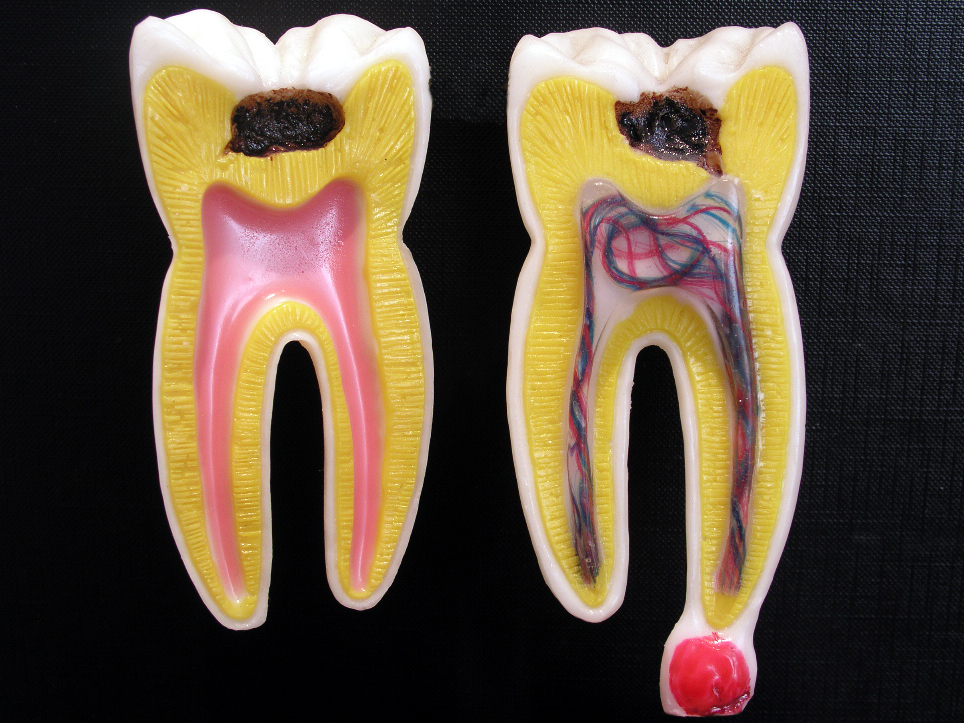Deep inside the center of every tooth is an area called the pulp chamber. An infection in the pulp chamber can be painful and lead to serious dental issues. What exactly is dental pulp? And how does dental pulp get infected?
What is Dental Pulp?
Dental pulp is sometimes called the root of the tooth. Much like the roots of a tree, it is the pathway for nutrients to go up into the tooth. The pulp is made up of nerves and blood vessels, surrounded by a protective layer called the dentin. Encasing the dentin is the hard, outer shell of the tooth: the enamel. Dentin is softer than enamel. If anything makes its way through the enamel to the dentin, the pulp inside the pulp chamber underneath is at risk of infection and decay.
What is an infection?
An infection occurs when disease-causing bacteria invade living tissue. The pulp inside a tooth is living tissue too, and so can become infected. The condition is sometimes referred to as pulpitis.
Typical indications of a dental pulp infection are toothache pain, especially while chewing, and sensitivity to hot or cold food and drink. Sometimes it will also include a darkening of the tooth enamel or swelling and tenderness of the gums.
Some patients may also experience symptoms such as a fever, swelling in the face and cheek, or tender lymph nodes under the jaw.
How Did the Infection Get There?
The most common way for bacteria to get into dental pulp and cause an infection is through dental carries, more commonly known as tooth decay. Tooth decay is the result of acids and bacteria building up on teeth in the form of a sticky substance called plaque. If plaque isn’t cleaned off regularly, cavities can appear.
Cavities start out as small holes in the tooth’s enamel, but can grow if they aren’t filled by a dentist. When a cavity gets bigger and deeper, it can eat through the enamel to the dentin. From there, it is a short trip through the dentin to the pulp chamber.
Cavities aren’t the only cause of infection. Anything that weakens or breaks through tooth enamel and dentin, exposing pulp to harmful bacteria, can cause pulpitis. Teeth broken or fractured through a physical injury can allow infection in. In some rare cases, overuse or incorrect dental procedures can be to blame. Excessive drilling or light curing can cause weak spots making tooth roots vulnerable.
Why Does Infected Dental Pulp Hurt So Much?
Inflammation is one of the signs of infection. Whether from decay or other trauma, when bacteria invade dental pulp, there will be swelling. Because the pulp is enclosed in dentin and enamel, the inflamed tissue is trapped. There is nowhere for the swelling to go, so the pressure builds up inside the tooth. This causes a lot of pain.
Repairing an Infected Tooth
It is best to see a dentist immediately at the first sign of mouth discomfort. Cavities, when discovered early, can be filled with little pain and at a low cost. Problems that have progressed to infection of the pulp require more complex and more expensive treatments.
Dental pulp that is infected is normally treated with a root canal procedure. The dentist may do it him or herself, or they may refer the patient to an endodontist. Endodontists specialize in root canals. The first step is a pulpectomy, where the infected pulp tissue is removed from inside the tooth. The empty pulp chamber is cleaned and then filled. The final step is sealing the tooth so that no further bacteria can get inside.
Root canals have a reputation for being painful, but they’re really not bad. The article Does a Root Canal Hurt as Much as They Say? explains the procedure step by step.
Removing an Infected Tooth
If infected pulp goes untreated, an abscess can form. This happens when the infection grows and the bacteria leaks out of the pulp chamber into the space between the tooth and jaw bone. A swollen and painful lump will form on the gum above the infected tooth. In very serious cases, the infection can spread to the jaw bone, ear, sinuses, or neck. In rare, serious cases, patients can even develop sepsis.
When pulp infection is extensive, or if an abscess has formed, it’s sometimes an indication that the tooth and its roots are dead. Extracting the tooth is often the only option. The lump that results from an abscess is filled with infected fluid. The dentist or endodontist first step will be to drain it. Antibiotics may be prescribed to stop the infection from spreading any further.
How Can I Prevent Infection?
The number one way to prevent dental pulp from getting infected is by practicing good dental hygiene. The best oral care habits include:
- Routine brushing with fluoride toothpaste
- Daily flossing
- A healthy diet that keeps sugary foods and drinks to a minimum
- Regular visits to the dentist for an exam, professional cleaning, and x-rays (our online tool can help you find one near you)
- Consider having sealants applied if particularly cavity prone
- See a dentist at the first sign of pain, or if a tooth chips or cracks
If a patient does all they can to prevent tooth decay and cavities in the first place, bacteria won’t get the chance to make it to the tooth’s root.


